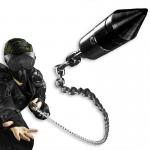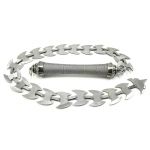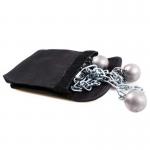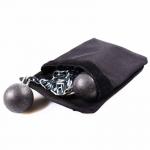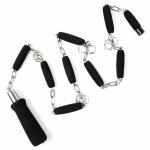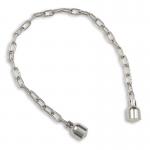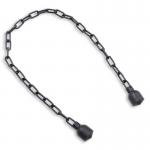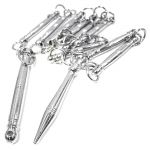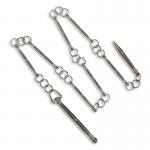Chain Weapons - Kusarigama, Flails, Chain Whips & Bolas
-
$20.95
-
$74.95
-
$19.95
-
$26.95
The kusarigama is a traditional Japanese weapon that combines a kama (sickle) with a weighted chain. Practitioners use the chain to entangle an opponent's weapon or limbs, then close in to strike with the sickle. The art of handling the kusarigama, known as kusarigamajutsu, was practiced by samurai and ninja alike. Its versatility made it effective in various combat scenarios, especially against swordsmen.
Another notable Japanese chain weapon is the kusari-fundo, also known as the manriki-gusari. This weapon consists of a short chain with weights at both ends and was often used by law enforcement during the Edo period for subduing suspects without lethal force. Its compact design made it easy to conceal, and its versatility allowed for a range of techniques, from strikes to joint locks.
In Chinese martial arts, the chain whip, or jiujiebian (nine-section whip), is a prominent example of a flexible weapon that requires exceptional skill to master. Comprising multiple metal segments connected by rings, the chain whip is used in disciplines like wushu and kung fu for both performance and combat. Its design allows for rapid, fluid movements that can strike from unexpected angles, making it a challenging weapon for opponents to defend against.
The chain whip's construction often includes a metal dart at one end and a handle at the other, with cloth flags attached to enhance visual appeal and provide auditory feedback during practice. These flags help the practitioner gauge the whip's position and movement, reducing the risk of self-injury. Mastery of the chain whip involves complex techniques, including wrapping and unwrapping the chain around the body to build momentum and control.
Beyond the Asian martial arts traditions, chain weapons have also appeared in European history, most notably the flail weapon. The medieval flail typically features a wooden handle connected by a chain to a spiked metal ball. While its exact use in historical combat is debated, the flail's design allowed it to bypass shields and armor, delivering powerful blows. Variants like the ball and chain weapon and the chain scythe demonstrate the adaptability of chain-based designs in different cultural contexts.
Bolas are another fascinating example of chained weapons with deep historical roots. Traditionally used by South American gauchos as a hunting tool, bolas consist of two or more weighted balls connected by cords or chains. When thrown, the weights spin through the air and wrap around the legs of a target, tripping or entangling them. While not originally developed for hand-to-hand combat, bolas earned their place in martial arts-style training because of their precision, speed, and utility in disabling opponents from a distance. They're a unique option for anyone exploring chained weapons beyond the usual flails and chain whips, and they offer a fun and skill-based challenge for practitioners who like ranged entanglement techniques.
At KarateMart.com, we recognize the enduring appeal of chain weapons for martial artists, collectors, and enthusiasts alike. Our selection includes traditional designs like the kusarigama weapon and the nine-section chain whip, as well as modern interpretations suitable for training and demonstration. Whether you're interested in the historical significance of these weapons or their practical applications in martial arts, we offer quality options to meet your needs.
It's important to note that chain weapons demand a high level of skill and respect. Their flexible nature makes them challenging to control, and improper use can lead to injury. We recommend that practitioners seek proper instruction and use appropriate safety gear when training with these weapons.
Check out our selection of chain martial arts weapons to find the right one for your training. From the elegance of the wushu whip chain to the formidable presence of the medieval flail, each weapon offers a unique experience that reflects the rich tapestry of martial arts history.
Flail vs Mace - What's the Difference?
The flail and the mace are often confused with each other, especially in pop culture where the terms are used interchangeably. But when you break down the mechanics, history, and design of each, the difference between a flail and a mace becomes very clear.
A flail weapon is typically made up of two parts: a handle and a striking head, which are connected by a flexible link; usually a chain. That chain connection is what defines it. The head might be a spiked ball, a solid weight, or even multiple weights on multiple chains in more complex designs. This flexible connection gives the flail a unique advantage: it can whip around shields, bypassing direct defenses, and strike at odd angles. That made it unpredictable and dangerous, even in armored combat. It also made it incredibly difficult to master, since the chain introduces momentum and recoil that can be as dangerous to the user as it is to the enemy. Some flails were short and single-handed, while others were longer and required two hands. There are also agricultural roots in the flail's design, as farmers originally used tools similar to flails for threshing grain. It's believed some weaponized flails were adapted directly from those farming tools.
The mace, on the other hand, is a solid weapon. It's a single piece or a rigid shaft with a striking head (usually metal) attached directly to the top. There's no chain or flexible component. Maces were made to deliver crushing blows through armor. They were widely used throughout the medieval period by knights, foot soldiers, and even clerics who were forbidden from shedding blood but still wanted a battlefield presence (thus the blunt force trauma of a mace didn't technically "shed blood"). Maces often featured flanged or knobbed heads to concentrate force into smaller areas and increase penetration on impact. Unlike the flail, the mace was easier to control and required less finesse to use effectively in the chaos of a melee.
So, when you picture a ball and chain weapon, that's a flail. When you think of a spiked or flanged metal club, that's a mace. If it bends or swings on a chain, it's a flail. If it's solid and stiff, it's a mace.
Both weapons had their place on the medieval battlefield, but the flail's unpredictable arc made it less commonly used in real warfare compared to the more practical mace. Still, it carved out a place in history, fantasy games, art, and martial arts, because of its intimidating look and unconventional motion.
What is the difference between a Kusarigama and other chained weapons?
The kusarigama is unique among chained weapons because it combines a traditional farming sickle, called a kama, with a chain and a heavy iron weight. Most other chained weapons, such as the manriki-gusari (weighted chain) or the nunchaku, do not include a bladed component. Instead, they rely solely on striking, trapping, or entangling techniques. The kusarigama's curved blade gives it the ability to cut and slice in addition to the long-range attacks possible with the chain, making it one of the most versatile and complex Japanese martial arts weapons.
Because of its dual design, the kusarigama requires a different skill set compared to other chain-based weapons. Practitioners must learn how to manage the range of the swinging chain while also controlling the blade for close combat. This balance of long-distance and short-distance fighting is what sets the kusarigama apart from simpler chained weapons and why it holds such a prominent place in martial arts history.
Is a Kusarigama the same thing as a chain and sickle?
Yes, the kusarigama is often referred to as a "chain and sickle" weapon, but the Japanese term has a more specific meaning. The word "kusarigama" comes from "kusari", meaning chain, and "kama", meaning sickle. Unlike a simple farm sickle tied to a rope, the traditional kusarigama was carefully constructed with a forged metal kama blade, a sturdy length of chain, and an iron weight attached to the end. This made it a highly effective weapon in the hands of skilled samurai and ninja.
Over time, the phrase "chain and sickle" became a way to describe the kusarigama in English, but the weapon itself is more advanced than the literal translation suggests. The weighted chain was used for striking, trapping, and disarming, while the sickle provided cutting power at close range. Together, these elements made the kusarigama one of the most feared and versatile chained weapons in Japanese martial arts.
Was the Kusarigama really used by ninjas or just samurai?
The kusarigama was used by both samurai and ninja, though often for different purposes. Historical records show that certain samurai martial arts schools, or koryu, included kusarigama techniques as part of their training. In these systems, the weapon was studied as a battlefield tool, teaching warriors how to control the distance of an opponent with the chain while finishing with the sickle in close combat.
Ninja, on the other hand, are believed to have valued the kusarigama for its versatility and unpredictability. The weapon could be concealed or disguised as a farming tool, which suited the ninja's emphasis on stealth and deception. Its long chain allowed for surprise attacks, disarming, and entangling, while the sickle could be used in quick, decisive strikes. Because of this dual use, the kusarigama became associated with both ninja strategy and samurai martial tradition, making it one of the most iconic chained weapons in Japanese history.






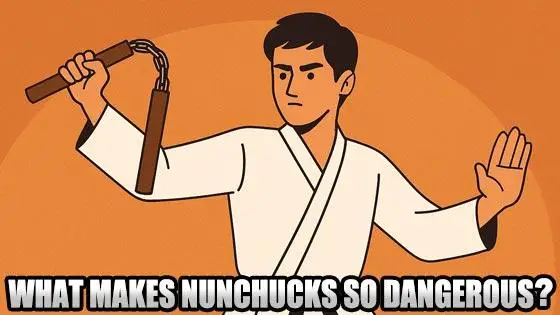





 (3)
(3)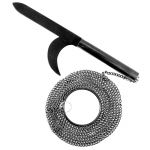
 (1)
(1)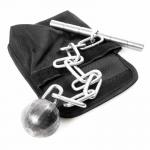
 (2)
(2)